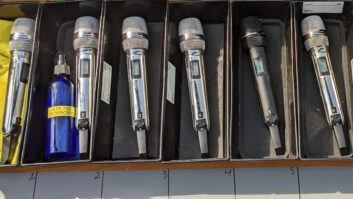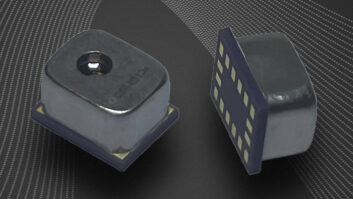WASHINGTON, D.C.—The Federal Communications Committee’s August 5 rulemaking helped bring the future into slightly better focus for wireless microphone operators in the United States. The new rules amending unlicensed operations under Part 15 and licensed use under Part 74 in preparation for next year’s Incentive Auction of the 600 MHz band signals a loss of spectrum for the pro audio community, yet does attempt to accommodate the longer-term needs of wireless microphone users.
The broadcast television spectrum Incentive Auction is intended to free up bandwidth for the delivery of high-speed internet access over the unused frequencies between TV stations—so-called “white space”—including to new unlicensed consumer devices. Although the FCC began rulemaking in 2008 to prevent interference between the expected new consumer technologies, existing wireless microphones and TV broadcasters, no mobile white space devices have yet been introduced.
The FCC has relaxed the rules and will now allow portable devices into TV channels 14 to 20, comments Mark Brunner, senior director of global brand management at Shure. “Which is unfortunate, because a lot of wireless microphone equipment was purchased there with the foresight that it was not going to be occupied by portable devices.”
The auction plan lays out a timetable extending over several years for the new consumer wireless services to be established and for wireless mic operators to vacate the 600 MHz band. If that seems like déjà vu to those forced out of the 700 MHz band during the switchover from analog broadcast to digital television, this time there is an added wrinkle: There will be no compensation available to replace or retune existing wireless audio equipment inventory, some of which undoubtedly has years of useful life remaining.
The auction, which now has a start date of March 29, 2016, introduces a number of variables that will affect the spectrum ultimately accessible to wireless mic users. But as Brunner comments, “If all of the dominoes fall in a certain direction, we will come out of this with some very usable chunks of spectrum for wireless operation, albeit in a reduced overall UHF footprint.”
The new rulemaking expands opportunities “for licensed use in the remaining TV bands by allowing greater use of the VHF channels and permitting co-channel operations inside DTV contours without coordination if TV signals fall below specified threshold.” It will additionally “expand eligibility for licensed use of the 4-megahertz portion of the 600 MHz duplex gap to include all licensed users in the TV bands (broadcasters, cable programming networks, movie studios, and operators at major sporting/concerts/theater venues).” The duplex gap is an 11 MHz-wide buffer between the uplink and downlink spectrum set aside for the new telco services.
The FCC is also providing licensed operators with alternative spectrum, although less than was previously available. “It doesn’t replace everything we’re losing, but it’s good news,” says Roger Charlesworth, executive director of the DTV Audio Group. “I think this is a direct result of the DTV Audio Group coming in with manufacturers, networks and end users. We successfully lobbied as a group and proposed solutions from a unified position.”
Specifically, a new FCC Report and Order offers “access to significantly more spectrum in the 900 MHz band; access to a portion of the 1435-1525 MHz band at specified times and places, subject to coordination requirements that protect critical aeronautical mobile telemetry; and access to portions of the 6875-7125 MHz band.” The FCC has also taken action to accommodate unlicensed wireless mic use in the duplex gap, in guard bands between services and the 600 MHz service band, “while at the same time protecting licensed users from harmful interference.”
Proposals included ENG wireless equipment being given some dedicated spectrum in the duplex gap. But the FCC’s new rules could place TV stations in the gap in some markets and a portion has also now been opened to unlicensed mobile devices.
The 900 MHz band and 1435- 1525 MHz are not suited to ENG use, according to Charlesworth. “Both of those are good for large, planned events where you can work around the incumbents.” A band at 2020-2025 MHz with no Federal frequency assignments is an appealing possibility for ENG, he comments.
There are other variables, says Brunner, the outcome of which will not be known until after the auction. For example, the lower guard band between TV and the wireless downlink bands could end up being 7, 9 or 11 MHz wide. “If it’s 11 MHz wide, then there’s a good chance that wireless mics will be able to utilize the lower 4 MHz of that exclusively,” he says.
“If the auction is highly successful, it will take spectrum all the way down below TV37 [a channel reserved for radio astronomy], which means that a lot of spectrum will be removed [from wireless mic use] from the band. But that will also create guard bands around channel 37, which in effect will be available for nationwide wireless mic use,” he says.
The additional spectrum in the 900 MHz band and above will require new products with features that prevent interference with incumbents at those frequencies, which includes flight testing and studio-to-transmitter links. “These aren’t things that are sitting on the shelf today,” says Brunner.
“For unlicensed operators in the TV band, it is definitely going to be more crowded with potentially some higher sources of interference. All we can do as manufacturers is try to make our products more robust to interference and to help educate operators on best practices of antenna placement and other things to make sure that the signal is as strong as it can be.”
FCC Adopts Rules for Unlicensed Services in TV and 600 MHz Bands
fcc.gov/document/amendment-part-15
FCC Adopts Wireless Microphone Rules
fcc.gov/document/wireless-mics







